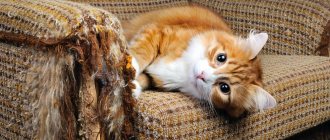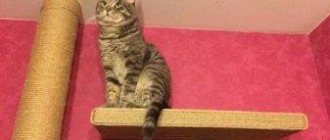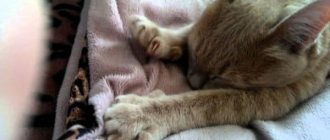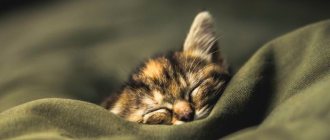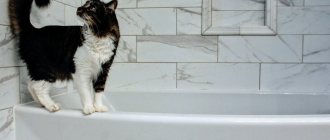In nature, a cat’s life often depends on the sharpness of its claws, because they allow them to excellently climb trees, defend themselves from predators, and defend their territory from competitors. This is why sharpening claws is a necessity .
During this process, pets renew the worn surface of their claws so that they are always in working order. In the natural environment, trees allow you to sharpen your claws, but what about your pet at home? This is where furniture and wallpaper come into play, which makes the owners worry about repairs. But it’s not difficult to cope with this situation: we have a few tips to make the cat be friends with the furniture, and you with the cat.
Why do cats sharpen their claws?
There are many reasons explaining the natural behavior of representatives of the feline family:
- Physiology. The claws are constantly growing, and over time the old nail plate is replaced by a new, sharper and stronger one. During this, the animal experiences discomfort and inconvenience, as hangnails may form on the paws. To get rid of unpleasant sensations and to speed up the process of changing claws, cats sharpen them on what they consider to be fairly hard surfaces.
- Cats fight for territory. Veterinarians and zoologists say that the tips of a cat's paw pads contain sweat glands necessary for unique scent marks. Thus, the cat makes it clear that he is the boss here.
- This is a kind of fitness to maintain physical shape. While sharpening its claws, the cat uses many muscles, thereby subjecting them to considerable stress.
- Fighting stress. Perhaps damaged furniture and tattered wallpaper are the result of a nervous shock the cat has experienced, or he is simply trying to attract your attention.
Reasons for this behavior
Typically, cats that are raised from a young age quickly understand the rules established in the home. There are several possible reasons why a cat living in a house allows itself to tear up wallpaper and furniture upholstery. Let us note the main ones.
- Paw warm-up. Animals need a kind of gymnastics for their paws. By tensing and relaxing the muscles of their paws, they keep themselves in excellent shape. This exercise not only warms up the muscles, but also perfectly develops the toes.
- Stress relief. Often, cats, in addition to tearing the furniture upholstery, touch it with their paws and bite into it with their teeth. This is an instinct inherent in small kittens; many adults retain it throughout their lives. This way they calm themselves, relieve stress and completely relax before bed.
- Sharpening claws. The stratum corneum of cat claws is renewed by shedding its top layer. This is possible if the cat chews its own claws, but since it is much easier for him to scratch his claws on the carpet, furniture or wallpaper, this is exactly what he does. This is what animals that live at home do (street animals usually dig their claws into the bark of trees).
- Designation of your territory. There are sweat glands on your pet's paws. An animal-scented secretion is released when the cat marks its territory. The pet does this so that other animals in the house do not encroach on the marked sofa or part of the wall by sniffing them. This is how the cat tells other animals who is boss in the house.
- Discomfort from excess length. Cats cannot move comfortably with long claws. Itching appears in the pads of the paws, the claws acquire hangnails, and walking becomes painful. At this moment, the animal doesn’t care what to pull its claws on, just to get rid of the problem that has arisen. It can tear not only wallpaper or upholstery, but also wooden furniture.
Cats' Favorite Surfaces
Probably, upholstered furniture most often suffers from cat claws. It is not for nothing that cats choose armchairs, poufs or sofas as victims; their choice is not accidental. If the animal lives in a natural environment, the main accessory for manicure procedures is tree bark; in an apartment, the cat has no choice but to use an alternative option - upholstered furniture.
In addition, purrs do not mind testing window curtains, carpets, cabinet furniture facades, etc. for strength. There are also surfaces that cats are not interested in:
- ceramic tile;
- stone;
- plaster;
- plastic;
- linoleum;
- parquet;
- laminate and others.
Unfortunately, the materials listed are not used to make furniture, so your furnishings are still at risk. To somehow protect the upholstery or hide existing damage, you can use protective covers or restore the furniture. Next, we will talk about methods that allow you to wean a cat from tearing up furniture and are aimed at re-educating it.
Why does an animal ruin furniture?
There are several reasons why a cat scratches furniture and wallpaper. For example, this is how she performs “physical gymnastics.” By extending and retracting its claws, the pet stimulates the work of the ligaments. It also strains and stretches muscles, kneads joints.
The natural need of the feline species is to grind off the upper stratum corneum from the claws, since it will interfere with the animal’s movement and can dig into the pads on the paws.
In nature, pets do this with the help of trees, so they may mistake home furniture or wallpaper for a natural scratching post.
There are psychological reasons why a cat tears up furniture:
- Jealousy of other pets or defense of one's territory. On the surface of cats' paws there are special glands that secrete pheromones. The human sense of smell is not able to distinguish this smell, but for animals it means that the territory belongs to the creature that marked it. They can interrupt the marks of other pets with their own.
- A stressful situation in which a cat finds itself can become a reason for property damage. For example, if the animal’s owner has changed or the owner pays too little attention to the pet. Also, cats are always stressed due to moving to another place of residence or getting a new pet.
The death of the owner and his long absence from home can negatively affect the animal’s psyche, which also often serves as a reason for scratching interior items.
The reason why an animal scratches furniture is often due to age. Little kittens have not yet been trained in anything, and may simply not know that they should not tear up the sofa or wallpaper. Also, young animals are often very active and playful. They do it out of boredom, to get attention or just to get some exercise.
If you don’t teach a young pet the right place to sharpen its claws, it can get used to damaging upholstered furniture, but it’s much more difficult to wean an adult animal off.
Spray bottle in the fight against cat claws
You can try to stop your cat from scratching the sofa using a regular spray bottle filled with clean water.
It is a well-known fact that representatives of the cat breed do not like water and avoid contact with it in every possible way. This can be used in the fight to preserve the normal appearance of your apartment. As soon as the purr decides to sharpen its claws on your favorite sofa, direct a stream of water at it and thoroughly wet the scoundrel.
Advantages of the method:
- works after systematic punishment;
- does not require the purchase of special devices;
- does not come with any costs.
Minuses:
- the technique is effective only when you record the cat’s intention and immediately punish it;
- As soon as the smart cat is left unwatched, he will continue his dirty deed without delay.
Tips and tricks
You need to feel all the responsibility if you decide to get yourself a pet. And it’s worth thinking through everything down to the smallest detail so that living together between you and the kitten becomes as harmonious and comfortable as possible. In addition to furniture, pets can tear up wallpaper, so it’s worth considering this point and replacing it with paint or plaster.
In addition, you can use various devices to solve the problem of how to stop a cat from scratching the sofa:
- Citrus. Cats really don't like citrus smells, so it's worth buying an oil-free spray with the scent of lemon, orange or grapefruit. They need to spray all surfaces that the cat damages with its claws. You can sew bags filled with dried zest; they are placed in places that need to be protected. You can also use spices.
- Water. You need to pour water into a spray bottle and immediately after the animal’s offense, sprinkle it in its face. It is worth punishing him immediately after an offense, otherwise the pet will not understand why he was punished and will continue to damage the furniture.
- Loud noise. A good way to wean your pet from bad habits are objects that make a loud noise. You can buy such a rattle at a children's or music store, or you can make it yourself: put a few coins in a tin can. When your pet once again encroaches on your favorite leather sofa, take the rattle in your hand and start rattling it. Do this constantly when your pet misbehaves so that the rule is learned.
- Voice commands. This method is similar to a ringing noise. If everything is done correctly, then any animal can be trained. And as soon as it is about to claw, then shout loudly and loudly: “You can’t!”, “Scram!” The commands should be repeated until the moment when the desire to tear things dear to you disappears.
- Inflatable ball. This method is effective, but inconvenient for the owner. It consists of inflating several balloons and tying them to the crime scene. When the cat wants to put its claws in order, the ball should burst. Such a loud sound will scare him away and the fear will remain that it could happen again.
The main thing to remember is that it is useless to scold an animal 5-30 minutes after the incident; this must be done immediately, otherwise the cat will not understand why it is being scolded.
Cats don't like strong scents - we use this against them
If spraying with cold water does not bring results, you need to look for a new effective method that will help bring some sense to the animal. Many breeders use scents in this matter, for example, a bright citrus aroma.
In some cases, it is enough to put a slice of lemon next to your favorite place for manicure and the cat will not repeat his old mistakes for a long time, leaving his favorite carpet alone. You can use citrus essential oils, but under no circumstances apply them to the damaged area, so that you don’t have to figure out how to remove the resulting stains. Specialized veterinary stores have special repellent sprays and fumigators:
Pros:
- efficiency 99.9%.
Minuses:
- aroma traps will have to be constantly updated, since natural odors quickly disappear.
Affection and attention are key success factors
When you bring a furry ball into your home, you love it selflessly, like a parent. Your task is to maintain this attitude, despite everyday ups and downs. After all, everything that sells can be bought, and sincere love and affection are priceless.
Don’t forget to talk to the cat and praise it, even for small things, as they say, “a good word is nice to the cat.” According to the experience of most cat owners, experts and animal psychologists, all troubles lie in a lack of understanding of the true reasons for the behavior of the ward. The conclusion is quite simple - start with yourself. If the cat has already ruined the wallpaper or the sofa, this cannot be corrected, but this is a reason to draw conclusions. You overlooked and you did not care, and not the cat is bad and stupid. As soon as you understand this axiom, you will stop being angry with your pet, and this is the first step to success!
Scotch tape will help preserve furniture
If for some reason the previous two methods did not work or did not suit you, try retraining the cat using regular double-sided tape.
The fact is that cats really don’t like it when their paws stick to something, so they won’t sharpen their claws on a sticky surface. To test this method in practice, stick a sufficient amount of tape to the damaged side of the furniture, curtain, or window sill.
Pros:
- the cat will not want to deal with the unpleasant sticky surface and will lose interest in it;
Minuses:
- Because of the sticky tape, the interior will, of course, not benefit; you will have to endure some inconveniences until the bad habit is eradicated.
Why do cats scratch textiles and wallpaper?
Nature gave cats claws for a reason. They play an important role in the life of an animal: they help to grab the desired object and hold it for as long as possible. Another option is for the animal to be held using its claws on various inconvenient surfaces.
Claws perform another important function: the animal uses them to mark territory. The thing is that the spaces between the paw pads have glands. And the glands produce pheromones, which send signals to other cats in the area - there is already an owner here.
Another reason for sharpening claws is to relieve stress. For example, when very frightened, upset or overexcited, a cat scratches an uneven surface, thereby “letting off steam.”
Finally, overgrown claws simply get in the way of the cat. If she is not accustomed to a special scratching post, furniture or joints in the house will definitely suffer from her paws.
Trimming or declawing
You can get your favorite furry manicure done at a pet beauty salon, use the services of a groomer or veterinarian, or try to master a simple procedure yourself at home. For this you will need a nail clipper.
One of the simplest answers to the question of how to stop a cat from scratching furniture with its claws is help with manicure. If you decide to carry out the manipulation yourself, be patient, ask someone to hold the animal, act with extreme caution so as not to injure the delicate skin of the pet.
Those who have repeatedly unsuccessfully tried to wean a cat from the harmful habit of ruining an apartment often use a drastic remedy to prevent the cat from tearing up the furniture - declawing. From a common sense point of view, this is a barbaric procedure, as a result of which your animal will lose an important part of its body, will not be able to walk outside, will not be able to protect itself from the enemy and will be forced to go through a long rehabilitation period.
Effective ways
It is not easy to stop a cat from tearing furniture and wallpaper if it has already become a habit. Some owners prefer to change the type of wall and floor coverings. For example, cats are indifferent to plastic panels, ceramic and PVC tiles, high-class laminate, artificial stone and decorative plaster.
Some people prefer to cover upholstered furniture with thick fabric upholstery.
However, we must understand that even replacing the coating or an alternative to it will not be able to permanently wean the cat from scratching its claws and gnawing objects. This process is natural and vital. Therefore, you will have to not only wean yourself off, but also think about how to switch your attention to other subjects.
Let's consider the most effective methods of protection.
Repellent odors
You can try to wean your pet from a bad habit by treating his favorite scratching areas with a product with an unpleasant aroma. It is known that cats do not like the citrus smell, so this is worth taking advantage of.
This can be orange, lemon peel or essential oil.
However, oil is inconvenient because it leaves unsightly greasy stains on the surface. An alternative to citrus, ether or spray can be some spices (for example, coriander or chili), which can be used to treat some surfaces (not suitable for furniture on which a person sits).
Protective coatings
You can save the upholstery of a sofa and armchairs by using covers made of special fabric or so-called anti-vandal Euro covers. In specialized stores you can choose options with a coating that is too tough for cats and not for their claws.
They simply will not be able to stick their claws into the fabric.
Trimming and nail trims
You can stop your cat from scratching the upholstery and damaging the surface of the wallpaper in a more effective way by cutting the claws or gluing special plastic covers on them. To trim claws, purchase a special device - a nail clipper, literally cutting off 1-1.5 mm of the regrown length.
The device is quite convenient and allows you not to stretch out the procedure, and therefore the cat does not have time to get nervous.
The pads are put directly on the claws, having previously lubricated them inside with special glue. Don't worry too much about it being harmful. As practice shows, the glue is not so strong, but for some time the cat will not be able to damage the furniture upholstery and wallpaper.
Alas, at the same time she will not be able to retract her claws, and it will be difficult for her to jump, but she will still be able to provide temporary protection to objects.
Pulverizers and sprays
To prevent your cat from sharpening its claws and teeth on furniture, wallpaper and curtains, you can try using a spray bottle. Scaring can have an effect on individual individuals if it is done at the moment when the animal is tearing upholstery fabric or wallpaper.
You can also spray your favorite items with a special spray to repel your pet. Citrus-scented sprays are repulsive to some cats.
Available means
You can protect furniture and wallpaper using another method. For example, favorite places can be covered with sticky, sliding or rustling material on top. For example, stick double-sided tape or foil to the torn area of the wall.
Some people prefer to create a scaring noise when the cat sharpens its claws. To do this, use baby rattles or a bunch of keys.
scratching post
A special device for sharpening claws is an excellent and effective way to save both furniture and wall cladding. It can be either an individual item or part of a play complex for a cat. Its shape can be very diverse, as well as its material.
Cats like large play complexes, because this is their territory where they can spend a lot of time. And this allows you to save the owners’ upholstered furniture.
Equipment for a personal sleeping area
To prevent your cat from tearing up furniture and wallpaper, it is recommended to make a personal place for him to sleep. This will reduce the animal's stress if people have multiple pets. You can use special houses, sun loungers or ordinary cardboard boxes.
You need to choose a suitable space for installation and accustom the cat to it using training or aromatic substances (mint, valerian).
It is recommended to place the pet's house near a place where people are often present, since cats love company and rarely tolerate loneliness. It is necessary to wean other animals from trying to occupy someone else's house and equip a separate one for each.
This will reduce the number of stressful situations for cats and help prevent property damage.
Wallpaper protection
If an animal scratches wallpaper or furniture in one place, then you should get fabric covers. They are easy to attach to the surface using nails, glue, and paper clips. The damaged area can be covered with adhesive tape. It is subtle, but effective against cats, as they really don’t like it when something sticks to them.
You can also use a woven cotton rug that is attached to a wall or furniture. It, like fabric, will allow your pet to sharpen its claws without damaging interior items.
It is recommended to choose liquid, slippery wallpaper or replace old ones with them. This way, the cat will have nothing to cling to, and it will stop tearing at the wall. The most drastic solution may be to cover the damaged areas with tiles or decorative plaster.
If all else fails
If water and a scratching post do not solve the problem, you will have to think about how to stop your cat from scratching furniture, using more serious methods. You can use special silicone attachments for animals. They are attached to the claws with an adhesive substance and last from 1 to 2 months. After the upper horny part of the cat's toe peels off, the pad falls off along with it.
An alternative to silicone devices is surgical declawing. This procedure is not recommended for use as it is similar to amputating a human finger and is not humane.
You can also protect items from the kitten using covers. They are similar to fabric covers that are attached to the surface, but cover the entire furniture or a separate part of it. If a cat is tearing at an element of the interior, it is recommended to use a spray with a strong repulsive odor.
You can find it at a veterinary pharmacy or prepare it yourself.
This substance has an unpleasant aroma for cats and can discourage the animal from any furniture. You can mix essential oils, spices, citrus juice with water, or hang bags of spices near the problem area.
This method is not always suitable, since the listed substances emit an unpleasant aroma for humans and can also leave streaks and stains.
Install a scratching post at home
To preserve the original appearance of upholstered furniture, manufacturers of veterinary products have come up with special scratching posts that purrs can use for their intended purpose, without fear of being punished. Veterinarians and breeders recommend accustoming your kitten to a useful device from childhood, so you can be sure that the sofa and other upholstered furniture will definitely not interest the fluffy one.
The choice of scratching posts in the pet store is huge:
- in the form of a house or play complex;
- corners for protecting corners of furniture, connecting walls;
- in the form of a straight board, wave;
- in the form of a column.
These can be floor or wall structures, simplified products in the form of fabric-upholstered boards, or multifunctional houses with a sleeping area and several play compartments. Scratching posts are made from different materials; sesal, jute, natural wood, and carpet are used in production. Whatever option you choose, the main thing is to accustom the cat to it as early as possible. This can be achieved by using a variety of treats to attract attention, including catnip treats.
You can also apply special products to the surface of the scratching post to correct the behavior of the fluffy.
A scratching post is the best device
A great way to save your favorite items is a scratching post. With its help, you can save wallpaper and furniture without harming your pet. Moreover, now you can find a scratching post for every taste and color: from the simplest to the most intricate, built into a house on several floors. The materials are also different and your pet will find one that will impress him more than expensive coatings.
The shapes also differ: vertical, horizontal, inclined. To begin with, it is worth proceeding from financial capabilities and taking into account the material of manufacture. Observe what your animal likes to scratch the most.
It would be good to install the scratching post in your pet’s favorite place and secure it well. Everything should be as comfortable and pleasant as possible so that the animal likes it.
What you should pay attention to:
- Cats usually sharpen their claws after waking up, so it is best to place the scratching post near their sleeping area.
- You should spray it with a spray that arouses interest among animals, or tie a toy there.
- After the scratching post is installed, keep an eye on the cat. As she sharpens her claws in the right place, give her a treat.
- If you suddenly find an animal doing leprosy, do not scold it, but take it to the scratching post.
- Claws must be trimmed very carefully. You should buy a special nail clipper in the store and cut only the light part of the nail. Do not touch a blood vessel under any circumstances, otherwise your pet will never let you near its claws again.
- If the cat continues to damage wallpaper and furniture after the scratching post, then immediately after the crime, scare it.
- After purchasing a scratching post, try to save your favorite places with tape, foil, and sandpaper. Create the most inconvenient conditions for sharpening claws in places that are inconvenient for you.
How to stop your cat from scratching furniture using alternative methods
If you have tried all of the listed methods in your arsenal and none of them have proven effective, you need to try alternative methods of combating a bad cat habit:
- Try putting special anti-scratch guards on the cunning pest's claws. Each claw is fitted with a silicone attachment, which is attached to the surface of the claw with glue, which prevents accidental removal of the accessory.
- Furniture covers. To protect your favorite bed, new sofa or comfortable chair in which you like to drink hot tea and watch the evening news from the merciless claws, you can buy protective furniture covers, the material of which will not be of interest to the four-legged pest.
- Considering that cats choose only certain materials for sharpening their claws, you can replace the damaged material with something that will not arouse the purr's interest. So, in place of the destroyed wallpaper, you can put tiles or cover it with plastic panels.
- Try not to leave your cat alone with an object that she mistook for a scratching post; raising pets has not yet been canceled.
Unlike surgical declawing, the pet does not experience pain or significant discomfort, quickly gets used to the changes and eventually stops paying attention to the attachments. The only thing a cat with such a manicure cannot do is jump to a considerable height and damage your furniture, which means that the goal can be considered achieved. After the claws grow back, you will have to repeat the procedure of gluing new pads.
Reasons – physiological, psychological and behavioral
Correct behavior and etiquette are instilled in the kitten at a very early age, up to 3 months. Usually, the breeder or the cat mother directly raises the baby. If you decide to rescue a kitten from a shelter or from the street, the manners of your newly adopted ward may not please you. The positive thing is that you can stop a cat from scratching furniture, wallpaper or damaging other things at any age. Naturally, the older the cat, the stronger its habits and the more time it will take.
Many inexperienced owners prefer to punish their pet or even beat it, hoping to develop a conditioned reflex: if you touch the curtains, it will hurt. By acting in this way, the owner does not take into account at least two important factors:
The cat needs to sharpen its claws, and by digging into the sofa, it literally cleans off the dead layer of the nail plate.
All cats are territorial and mark their territory with scent. Between the fingers of the ward there are glands that secrete an odorous secretion. This is where every corner, curtains and door frames come under attack, since they are located along the perimeter of the home or room.
The second most popular reason is stress. If we summarize all the popular factors, we get the following conclusion:
Jealousy - towards other animals, a new tenant or a child. In this case, the cat will scratch the furniture with the smell of a stranger and the walls of “his territory.”
Territoriality – tattered curtains, wallpaper near the front door and windows, indicating the pet’s anxiety. Perhaps your purr sees other people's cats from the window or smells them near the door. Scratching surfaces, the pet leaves marks: “I live here, the territory is occupied!”
Conflict with other pets in the house – This will affect feeding areas, sofas and other shared areas where your pets (usually) have conflict.
Other stresses are a change of owner, moving, death or illness of a family member, long absence of the owner, lack of attention and/or care from the owner, etc.
The third reason, which is entirely dependent on the owner, is poor or untimely upbringing. Let us highlight several sub-points that will significantly affect the education process:
Age of the pet - young cats and kittens may simply not know that furniture and wallpaper should not be damaged.
Age of habit - if the pet has already tasted the delight of peeling off soft, textured, so alluring wallpaper and has done this several times, re-education will take longer.
Boredom is the lack of toys and, as mentioned above, attention from the owner.
By observing your pet, you can easily determine the reasons for incorrect behavior. If the pranks are associated with a lack of upbringing or the pet’s lack of self-confidence, it is necessary to immediately take up re-education. It’s worth starting with providing comfort and conditions for claw care.
General tips or how to stop a cat from tearing up furniture
Do not forget that representatives of the cat family are very smart and resourceful. To retrain an animal, you will have to “have a heart-to-heart talk with it,” be affectionate and attentive, carefully pointing out errors in behavior.
Aggression and physical punishment do not lead to a positive result; it causes stress in the pet and only aggravates the situation. As for education, you need to adhere to the following principles:
- make sure that the cat does not experience stress, surround it with love and sincere care;
- set the boundaries of what is permitted and do not allow them to be crossed;
- Do not hit a defenseless animal, this is a form of cruelty and is absolutely unacceptable.
We talked about how to wean a cat from tearing up a sofa and other interior items, and dwelled in detail on popular methods of combating a bad habit. You just have to choose which of these options you will use.
Check out the toys, teasers, and treats that will keep your furry pets occupied:
Selection and training to a scratching post
The easiest option is to purchase a scratching post, maybe even several, so that the cat has a choice. Scratching posts are made from sisal, hemp or burlap - natural materials are attractive to pets and do not cause allergic reactions.
It is important that the scratching post is secured and does not wobble or fall.
In modern stores there is such a variety of devices that it makes your eyes wide open. How not to get confused and choose something that your pet will like and fit into the interior?
There are several types of scratching posts:
- Wall-mounted. The stationary scratching post looks like a board and is mounted on the wall. It is covered with sisal rope or canvas. For animals that prefer to crawl into corners and walls, corner scratching posts were invented. They consist of two planks.
- Floor-standing. They are divided into volumetric and flat. Flat ones resemble ordinary boards of various shapes. They are installed on a flat, smooth surface, and the pet claws against it, as if against a carpet or wall. Volumetric sharpeners look like posts attached to a wide base.
- Complex. A whole set of multi-level sharpeners looks like a miniature sports field. Typically, such structures contain columns, shelves, and houses. In the complex, the cat can not only sharpen its claws, but also play and sleep.
You don’t have to buy a scratching post, but build it yourself: it doesn’t take much time or effort.
For some animals, a log or a good piece of wood without splinters is enough. The main thing is to take into account the pet’s attraction to the type of surface (fabric, rope, wood) and the type of plane (horizontal or vertical).
Be prepared for the fact that the cat will not immediately recognize the scratching post: the acquaintance may take several days. Move the cat's paws along the rough surface, slightly pressing on the pads so that the claws come out. The animal will not immediately understand that the device is convenient for sharpening its claws.
As soon as the cat starts tearing up the furniture, pick him up and carry him to the scratching post. Let him complete the action himself: then the skill will be firmly established.
Training will take from 1 to 3 weeks on average. Make it a rule not to let your cat finish scratching the furniture by immediately taking him to the scratching post. Don’t forget about praise and other protective measures - trim the cat’s claws and spray restricted areas with repellent spray. A set of measures will speed up the education process.
Plain water
This method will not work if your cat is not afraid of water. But the rest of the owners will find it extremely simple. It is enough to fill the bottle with water and install a special sprinkler. As soon as you notice that your pet is approaching the treasured place to do some mischief, feel free to spray it with water. After several unsuccessful attempts, the fluffy will forever lag behind the furniture.


